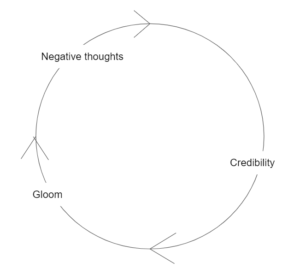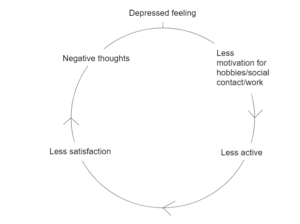Cognitive Therapy (CT) focuses on the connection between our thoughts and feelings. The way we interpret our experiences can play a major role in our negative feelings. Based on your experiences, you form ideas and beliefs about yourself, others and the world. These ideas are called ‘cognitive schemas’ or core beliefs. Based on these core beliefs, you can regulate and evaluate your behaviour, which makes life more manageable. In the past, these core beliefs might have been useful to you when coping with a period in your life, but they can cause problems later on in life. For example, these core beliefs can start to evoke negative thoughts, which limit your performance. A limiting core belief could be: “I have to do everything I do well, otherwise I am worth nothing”. Since a person simply cannot do everything well, there is a good chance that such a core belief will cause negative feelings eventually.
The emergence of the thought circle
Negative thoughts impose themselves automatically, without someone being consciously aware of their core beliefs or schemas. The occurrence of negative thoughts increases more and more and is often accompanied by an increase in depressed mood and other negative feelings. As the sadness grows, negative thoughts become more common, more intense and increasingly credible. Thinking negatively becomes a habit. That is why it becomes increasingly difficult to put these thoughts into perspective. All this, again, reinforces the negativity.
It is a vicious circle in which you can get trapped in: the sadder you feel, the more negative thoughts arise. These thoughts become more and more credible, which in turn reinforces the sadness. This vicious circle is shown below.

So, negative thinking can gradually become a habit. This is often the case with habits of which you don’t actually realize that you have them. This can make it seem as if a certain event leads directly to a negative mood, while there is actually a mediator: your thoughts. These thoughts are also called ‘negative automatic thoughts’ because of their negative consequences.
Vicious circle
When you combine the vicious negative behavioural circle and the thought circle, it results in the circle below. It shows that behaviour and thoughts are connected and influence each other.

Breaking the circle with cognitive therapy
The aim is to learn to break the circle. This can be done using cognitive therapy (CT). You will learn to investigate which thoughts are influencing or worsening your depressed moods, based on a situation that you experienced prior to your depression. You will take note of these thoughts and decide if they are realistic and correct. You will then begin to challenge these thoughts and try to look at the event from a different perspective. This can, in turn, affect your mood. Lastly, attention is paid to the core beliefs that underlie the automatic negative thoughts. These core beliefs and schemas are examined and adjusted as needed.
Source: Keijsers, G. P. J., Van Minnen, A., Verbraak, M., Hoogduin, C. A. L. & Emmelkamp, P., (2017). Protocol-based treatments for adults with psychological complaints.

 Print
Print 
